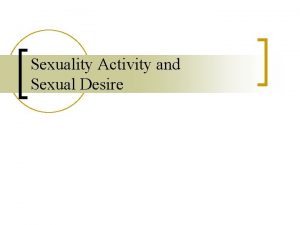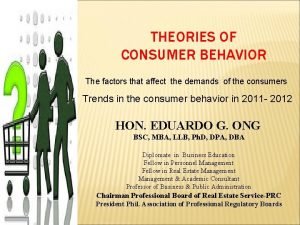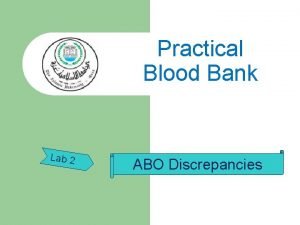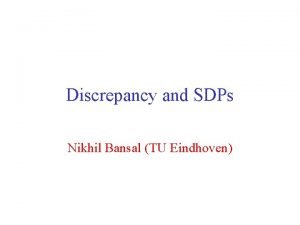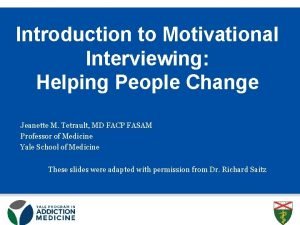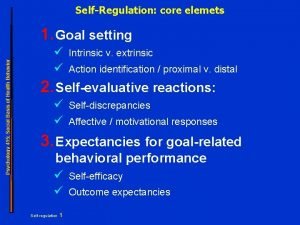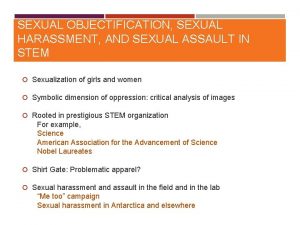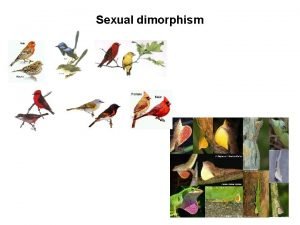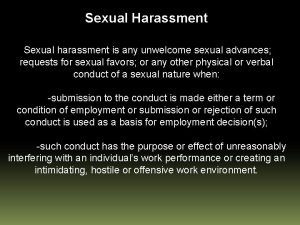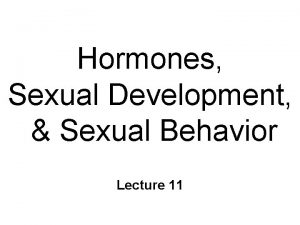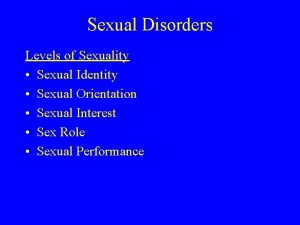Where Did IT go SEXUAL DESIRE DISCREPANCY Lisa























- Slides: 23

Where Did IT go? SEXUAL DESIRE DISCREPANCY Lisa Elieson, MA, LPC-S, CST Lisa@Hidden. Lakes. Counseling. com

2 BIGGEST TREATMENT CHALLENGE • A lack of empathy between partners. • Helping clients to understand that this isn’t a problem they have chosen. • No one is “broken. ” The relationship may just be trying to grow. • “Withholding” concepts are a myth.

3 WHY WOMEN SAY “NO” TO SEX June 23, 2017 by The Generous Husband

4 COMMON CAUSES OF LOW DESIRE • Sex for connection versus self validation • Stress • Enmeshed position that partner feels the same as you about sex (or anything else) • Body image • High physical intimacy may cause neglect of emotional intimacy. Some clients find it easier to be naked physically, but not emotionally • Low understanding of their own sexuality • Life changes (over time) • Health concerns • Problematic sleep • Longevity of relationship • Age

5 MASTERS AND JOHNSON (1966) Sexual Response Cycle Excitement Plateau Orgasm Resolution • There is an assumption that both genders work under this model Arousal • Basis for diagnosis in DSM III & IV Time

6 WHAT IS “NORMAL”? Normal Distribution Increasing Desire

7 BASSON’S BLENDED SEXUAL RESPONSE MODEL (2001) Willingness to Become Receptive Sexual Stimuli with Appropriate Context Spontaneous “Innate” Desire Motivation Multiple Reasons and Incentives for Instigating or Agreeing to Sex Psychological & Biological Processing Subjective Arousal Sexual Satisfaction with or without Orgasm(s) Nonsexual Rewards; Emotional Intimacy, Well-being, Lack of Negative Effects from Sexual Avoidance Arousal and Responsive Sexual Desire • Differences in Female Sexuality recognized • FSAID added into DSM-V categories

WHEN THE MALE PARTNER’S AROUSAL IS LOWER • Couples have better communication. • Better problem solving and teamwork. • Less blaming or dysfunction seeking. • High desire female partner expresses less entitlement to satisfying sex.

9 BUEHLER’S SYSTEMIC FRAMEWORK • Recognizes that each person operates within a complex system

10 SEX THERAPY AND THE PLISSIT MODEL (1974) Limited Information LI SS IT Specific Suggestions Intensive Therapy More Complex P More Training Needed Permission

11 ATTRACTION. WHERE IT STARTS… • Together and separate; in balance • Must “see” each other • Partners may feel selfworth is connected to sexual desire • Treat anxiety that may develop around having sex on demand

AROUSAL CYCLES “…we’ve taken one kind of intimacy – the type in which our partner accepts and validates us – and convinced ourselves this is what intimacy is. Thus we assume that intimacy hinges on acceptance and validation from our partner. ” - David Schnarch, Ph. D

AROUSAL CYCLES “Likewise we’ve confused ‘good communication’ with being understood the way WE want, and getting the response we expect. ” - David Schnarch, Ph. D

14 COMMON GENDER DIFFERENCES MALE FEMALE More visual receptors for sexual stimuli Wider variety of sensual stimuli Greater focus on sexual energy release, instead of buildup phases Greater enjoyment of sexual energy buildup Higher awareness of genital and psychological connection Fewer stimuli is found arousing Gap between physiological arousal and psychological arousal Psychological cues may be more important then physical Average cycle develops interest in about 3 days Wealth of arousing stimuli accumulates Needs average of 5 minutes of non-sexual touch and communication to trigger arousal Needs average of 15 hours of non-sexual touch and communication to trigger psychological arousal Less impacted by stress, but may be impacted by anxiety Cortisol levels may more greatly suppress testosterone functioning. Sexuality more impacted by depression, anxiety or stress Average cycle develops interest in about 10 days

15 MORE COMMON GENDER DIFFERENCES MALE FEMALE Greater role expectation to “be a man” Often little experience with their own genitals May feel anxiety about expert role in sex Prioritizes information about stability, commitment, social status, competence and kindness More focus on physical cues of health and longevity More concerned whether their partner is attractive, or other driven cues Some evidence that unique interests may form in adolescence Less flexible cues Likely to present with erectile dysfunction when they have low desire concerns Integrates emotional, social, cultural and physical cues More concerned whether they are attractive. May have self driven cues More flexibility and fluidity to cues

16 TREATMENT DIMENSIONS Communication Mindfulness Sensate Focus Medical Combatting Boredom

17 IMPROVE COMMUNICATION • Improve intimate communication with the goal of understanding each other’s unique sexual needs • The therapist’s comfort with asking direct questions lets the client know that talking about sex is okay - in session, and with their partner • Help the lower desire partner to set boundaries with a gentle “no. ” Boundaries can disrupt the cycle of anxiety-producing “duty sex” • Help higher desire partner to learn that sex is not be a reflection on self-worth • Psychosexual education; learn how the body works. Sexuality is a discovery • Watch for negative sentiment override between partners. Must be overcome with positive experiences • Sexuality is like sleep. We set the conditions and hope biology does its thing. Learn your ideal conditions

18 MINDFULNESS • Learning to be present and in the moment • Find small things that give any kind of pleasure, every day • Assess the 5 senses and learn to use them • Observe your thoughts without responding to them • Turn off you judging brain • Notice when your brain wanders and try to return to the present moment • Breathe deeply • Be in the present, i. e. , don’t be mentally at work when physically at home • There are lots of books and apps to support mindfulness

19 SENSATE FOCUS • Exercises for couples at home between sessions • Focus on non-anxiety producing touch in graduated episodes • Re-learning that touch is fun and for play • If touch becomes stressful, stop the interaction and process the event • Move away from goal directed sex and toward finding enjoyable touch • Use mindfulness strategies to help with relaxing touch

20 MEDICAL APPROACH • Since men present with ED, they go to their medical doctors and often get on Viagra to increase performance • Some medications may cause low desire, while some may cause high desire • Viagra has not worked for women because women’s arousal is generated through more psychological mechanisms, not just through blood flow • Women have tried off-label testosterone, and Flibanserin (Addyi) – Similar to depression treatment, there is some controversy within the feminist critique – Are we medicating women to make them more compliant to culture, or to male partners? Or are we helping women understand their own sexual narrative? • Consider time of day. Often people have an ebb and flow to their

21 COMBATTING BOREDOM • Often a problem associated with poor communication or rigid sexual boundaries • Explore what are acceptable sexual limits for them and the meaning thereof • Couples can come up with activities inside and outside the bedroom to make their relationship more interesting • When resistant to new activities in the bedroom, work on activities outside the bedroom. Play builds emotional intimacy • Discuss what makes the lower desire partner feel attractive and helps them to feel like a man/woman • How can the low desire partner improve sexual selfishness? What do they want more often? • Discuss other ways they connect in the relationship

22 REFERENCES Basson, R. (2005). Women’s sexual dysfunction: revised and expanded definitions. CMAJ: Canadian Medical Association Journal; Journal De L’association Medicale Canadienne, 172(10), 1327– 1333. Brotto, L. A. , & Basson, R. (2014). Group mindfulness-based therapy significantly improves sexual desire in women. Behaviour Research and Therapy, 57, 43– 54. Buehler, S. (2017). What every mental health professional needs to know about sex. New York: Springer Publishing Company. Diagnostic and Statistical Manual of Mental Disorders: DSM-5. (2017). Arlington, VA: American Psychiatric Association. Masters WH & Johnson V. (1966). Human sexual response. Boston: Little, Brown & Co. ; 7. Kaplan HS. Ogas, O. , & Gaddam, S. (2011). A billion wicked thoughts: What the world’s largest experiment reveals about human desire. New York: Dutton. Perel, E. (2006). Mating in captivity: Reconciling the erotic the domestic. New York: Harper. Collins. Schnarch, D. M. (1991). Constructing the sexual crucible: An integration of sexual and marital therapy. New York: Norton. Snyder, S. (2019). Love worth making: How to have ridiculously great sex in a long-lasting relationship. New York: St. Martins Griffin. Videos: David, L. (Writer), & Weide, R. (Director). (2000). The group [Television series episode]. In David, L. (Executive Producer), Curb your enthusiasm. Los Angeles, CA: HBO. Miller, K. G. , Siamis, K. , (Writer) & Sandrich, J. (Director). (1984). Knight to night: You’re not a mother night [Television Series Episode]. In The Cosby Show. Los Angele, CA: Carsey-Werner Company Talks, T. (2017, December 19). I've lived as a man & a woman -- here's what I learned | Paula Stone Williams | TEDx. Mile. High. Retrieved from https: //www. youtube. com/watch? v=lr. Yx 7 Ha. Ul. MY

THANK YOU Lisa Elieson MA, LPC-S, CST Lisa@Hidden. Lakes. Counseling. com 817. 854. 3201 ext. 2
 Deflationary theory
Deflationary theory Sari van anders
Sari van anders Sacrifice i do not desire
Sacrifice i do not desire Why did western nations desire lands in the pacific rim?
Why did western nations desire lands in the pacific rim? Discrepancy
Discrepancy Henry murray theory
Henry murray theory Data discrepancy report
Data discrepancy report Abo discrepancy chart
Abo discrepancy chart Gdp income approach formula
Gdp income approach formula Discrepancy example
Discrepancy example Safeguarding supervision training
Safeguarding supervision training Enterprise income verification
Enterprise income verification Jeanette tetrault
Jeanette tetrault Discrepancy assertion
Discrepancy assertion Discrepancy matrix morrison and wonnacott 2009
Discrepancy matrix morrison and wonnacott 2009 Discrepancy
Discrepancy Abo discrepancy examples
Abo discrepancy examples Develop discrepancy example
Develop discrepancy example Financial discrepancy
Financial discrepancy Blood group discrepancy
Blood group discrepancy Blood bank
Blood bank Size date discrepancy pregnancy
Size date discrepancy pregnancy Chapter 22 farewell to manzanar
Chapter 22 farewell to manzanar What did you do last summer
What did you do last summer
